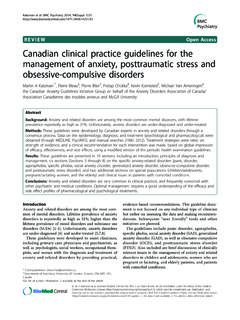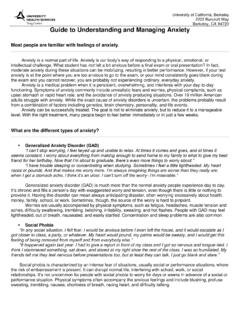Transcription of Administration and Scoring of the Generalized Anxiety ...
1 Administration and Scoring of the Generalized Anxiety Disorder-7 (GAD-7). PAR Staff 2. ChecKIT Series GAD-7. OVERVIEW displayed below the response options. Items cannot be skipped during Administration . The Generalized Anxiety Disorder-7 (GAD-7; Therefore, an advantage to administering the 2006) scale was developed by Robert L. Spitzer, GAD-7 via PARiConnect is the ability to capture Kurt Kroenke, Janet B. W. Williams, and Bernd a complete Administration each and every time. L we based on the diagnostic criteria for gen- eralized Anxiety disorder (GAD) in the Diagnostic GAD-7 items reflect the DSM-IV criteria for GAD.
2 And Statistical Manual of Mental disorders , Respondents are asked to rate each item for Fourth Edition (DSM-IV; American Psychiatric frequency of occurrence using a 4-point Likert Association, 1994). The measure was originally scale (Not at all = 0, Several days = 1, More than composed of 13 items, but only the 7 items with half the days = 2, and Nearly every day = 3). the highest correlations were included in the final instrument. Since its inception, the GAD-7 Scoring . has become increasingly popular in research (Dear et al., 2011) and clinical practice (Beard All responses are summed to calculate the and Bj rgvinsson, 2014).
3 Administration and total GAD-7 score. Scores range from 0 21 with Scoring , available on PARiConnect, take approxi- increasing scores indicating greater severity of mately 2 minutes. symptoms of Anxiety . GAD-7 Score Report Administration . Severity Ranges The GAD-7 is administered using PARiConnect, After generating a Score Report on PARiConnect, PAR's online assessment platform. Examinees an examinee's GAD-7 score will be plotted can complete the GAD-7 in-office or at a remote along a number line with shading to represent location via an email link, which launches the changes in severity of symptoms of Anxiety (see Administration .)
4 Detailed information on the Figure 1). Severity ranges are based on guidance use of PARiConnect is available under All Help in the initial validation study by Kroenke and Topics in PARiConnect. Each of the 7 items are colleagues (2006). displayed one at a time with a progress bar Figure 1. GAD-7 Score Report Figure Example None to minimal Mild Moderate Severe 0 5 10 15 20. 3. ChecKIT Series GAD-7. Cut-off Recommendations cut-off scores ranging from 5 to 10. They In the extant literature, several recommended noted the sensitivity and specificity approached cut-off scores have been suggested.
5 Kroenke et or exceeded 75% for all disorders and the al. (2007) found mean GAD-7 scores were , positive likelihood ratio exceeded when , , for GAD, panic disorder, social using a cut-off score of 8 or greater. Based on Anxiety disorder, and posttraumatic stress a recent meta-analysis, Plummer et al. (2016). disorder, respectively, compared to for recommended using a cut-off of 8 or higher individuals with no Anxiety disorder. They also to optimize sensitivity without compromising examined the sensitivity, specificity, and pos- specificity.
6 Table 1 shows the sensitivity, speci- itive likelihood ratios for GAD, panic disorder, ficity, and positive likelihood ratios of the afore- social Anxiety disorder, posttraumatic stress mentioned diagnoses using a cut-off score of 8. disorder, and any Anxiety disorder using GAD-7 or higher (Kroenke et al., 2007). Table 1. GAD-7 Classification Statistics Using Cut-Off Score of Greater Than or Equal to 8. Sensitivity % Specificity % Positive Likelihood Ratio Diagnosis (95% CI) (95% CI) (95% CI). Generalized Anxiety disorder 92 (83 97) 76 (73 79) ( ).
7 Panic disorder 82 (70 90) 75 (72 78) ( ). Social Anxiety disorder 78 (66 88) 74 (71 77) ( ). Posttraumatic stress disorder 76 (65 85) 75 (72 78) ( ). Any Anxiety disorder 77 (70 82) 82 (80 85) ( ). Treatment Recommendations The GAD-7 Score Report includes treatment recommendations based on an individual's score. These proposed treatment actions, shown in Table 2, are based on recommendations by Spitzer et al. (2006). Individuals with a score of 8 or higher are considered likely to be diagnosed with an Anxiety or related disorder.
8 Table 2. GAD-7 Recommendations Score Severity Recommendations 0 4 None to minimal No follow-up is warranted at this time. 5 7 Mild It is recommended to monitor symptoms and follow-up as indicated. 8 9 Mild This individual is likely to be diagnosed with an Anxiety or related disorder. Repeat Administration of the GAD-7 every 4 weeks to monitor symptoms. Follow up to determine if current symptoms warrant a referral to a mental health professional. 10 14 Moderate This individual is likely to be diagnosed with an Anxiety or related disorder.
9 Their symptoms are clinically significant and warrant further assessment (including diagnostic interview and mental status examination). and/or referral to a mental health professional is recommended. 15 21 Severe This individual's symptoms of Anxiety likely warrant active treatment. This individual is likely to be diagnosed with an Anxiety or related disorder. Further assessment (including diagnostic interview and mental status examination) and/or referral to a mental health professional is recommended. 4. ChecKIT Series GAD-7.
10 REFERENCES. American Psychiatric Association. (1994). Diagnostic Kroenke, K., Spitzer, R. L., Williams, J. B. W., and statistical manual of mental disorders (4th ed.). Monahan, P. O., & L we, B. (2007). Anxiety dis- orders in primary care: Prevalence, impairment, Beard, C., & Bj rgvinsson, T. (2014). Beyond general- comorbidity, and detection. Annals of Internal ized Anxiety disorder: Psychometric properties of Medicine, 146, 317 325. the GAD-7 in a heterogeneous psychiatric sample. Journal of Anxiety disorders , 28, 547 552. Plummer, F.


